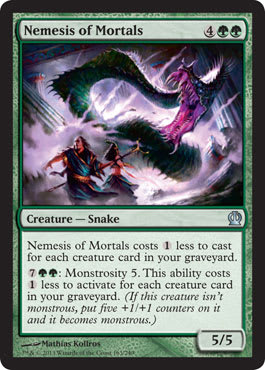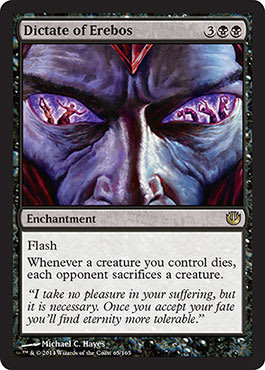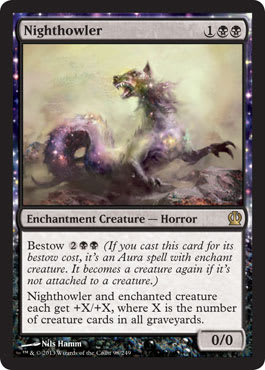Last week, I wrote about a constellation-based graveyard deck for Standard based on Strength from the Fallen. I've been working with the deck more since writing that, and I've come up with an updated version that could be a real contender in Standard, whether or not you're on a budget.
My initial thoughts on seeing Strength from the Fallen were that it was powerful but that it belonged in a different build of dredge than the decks Conley Woods and I had been developing separately. Last week, I explored that build, and while it was powerful, further testing revealed that the lack of Nemesis of Mortals hurt the deck's power significantly.
Initially, I thought it was inadvisable to try to combine the two strategies. After all, Kruphix's Insight can't grab Nemesis of Mortals, and Grisly Salvage can't grab Strength from the Fallen. However, I decided to experiment a bit, and I found that a two-and-two split worked out far better than I had anticipated, with Commune with the Gods bridging the gap between noncreature enchantments and nonenchantment creatures. Here's the current non-budget list:
Death Stars ? Journey into Nyx Standard | Mike Cannon
- Creatures (28)
- 2 Deathrite Shaman
- 2 Herald of Torment
- 2 Shadowborn Demon
- 4 Elvish Mystic
- 4 Nemesis of Mortals
- 4 Nighthowler
- 4 Nyx Weaver
- 4 Satyr Wayfinder
- 2 Pharika, God of Affliction
- Spells (12)
- 2 Grisly Salvage
- 2 Kruphix's Insight
- 4 Commune with the Gods
- 4 Strength from the Fallen
- Lands (20)
- 4 Swamp
- 6 Forest
- 2 Mana Confluence
- 4 Overgrown Tomb
- 4 Temple of Malady
- Sideboard (15)
- 2 Dictate of Erebos
- 4 Nylea's Disciple
- 2 Whip of Erebos
- 2 Shadowborn Demon
- 3 Golgari Charm
- 2 Eidolon of Blossoms
The only expensive cards in the list are the lands, and those can easily be replaced if necessary. Golgari Guildgate serves as a reasonable replacement for Temple of Malady, and basic lands could be substituted for the others.
Combining Forces
This deck really does get the best of both worlds. Nemesis of Mortals can often be cast as soon as turn three, putting control decks on their heels immediately and creating an impassable blocker against aggro decks.
Strength from the Fallen, on the other hand, turns any creature into a massive threat, and often, your opponent won't see it coming. I've played games against control decks during which my opponent tapped out for Jace, Memory Adept thinking it would keep him safe against my 1/1s, and I punished him for not leaving mana open by attacking for over 20 damage. Strength also performs well against aggro decks, forcing aggro opponents to leave back blockers or die instantly.
Nighthowler is still the beast that it always has been, but it now has the additional function of triggering constellation. Herald of Torment is similar, pumping up a creature and giving it flying to make a truly formidable threat. You can also just cast the Herald if you're planning on getting in with Strength from the Fallen the following turn.
Pharika, God of Affliction is a card that's kind of hit-or-miss, but it's very good in a lot of situations. When playing against midrange decks, the deathtouch tokens can be a nightmare. The tokens can also keep a Desecration Demon tapped down almost indefinitely. Perhaps most importantly, Pharika's Snakes can be used to trigger constellation and pump up your creatures after blockers have been declared.
Shadowborn Demon is a pretty decent removal spell, and it’s a great creature as well. In this deck, the card's drawback is often irrelevant, and although the non-Demon clause is sometimes annoying, its ability to easily dispatch cards like Stormbreath Dragon is huge. Note that the sacrifice trigger has an intervening-if clause, so if you can put the sixth creature in your graveyard before it resolves, you won't have to sacrifice anything. You can do this either by casting Grisly Salvage with the trigger on the stack or by stacking the trigger from Nyx Weaver so that it resolves first.
Speaking of Nyx Weaver, the card's exile ability is one of the tougher parts of the deck to use correctly. The most common way I've used it is by exiling the Spider at the end of my opponent's turn to return Strength from the Fallen and set up a lethal attack. However, returning Shadowborn Demon can also save you from certain death on occasion. Most of the time, you want to keep the Spider around as long as possible to keep milling cards, but if there's something you can return that will have a huge impact—or if it you need to chump-block with it anyway—the ability can definitely come in handy.
The Other Side
Dictate of Erebos was an innovation I came up with shortly after publishing time last week. It replaced Grisly Salvage and gave the deck a way to actually kill creatures that could be found with Kruphix's Insight. In the end, Shadowborn Demon is better for its immediate impact, but Dictate still has its uses. Against mono-black, it's incredible, making Desecration Demon actively terrible for your opponent. Even some giant Pack Rats can be taken down by Satyr Wayfinders if you have this enchantment on the board. It also works well in addition to Shadowborn Demon against midrange decks, giving you an assortment of spells with which to kill off your opponent's creatures.
Nylea's Disciple and Whip of Erebos help shore up the deck's very unfavorable matchup against burn and certain other aggressive decks. With large creatures like Nemesis of Mortals and Nighthowler in the deck, a single attack with the Whip on the battlefield can give you enough life to basically win the game on the spot. Although Skullcrack works well against Nylea's Disciple, against Whip of Erebos, it will only buy your opponent one turn. Whip of Erebos is also good against removal-heavy decks like control and mono-black, giving you a way to bring back your enormous creatures for another attack.
Eidolon of Blossoms can give you some much-needed card advantage against mono-black decks, at the very least giving you a free card and forcing your opponent to use a removal spell. If it stays on the board long enough for you to trigger it a few times, it can become very difficult to lose the game.
Shadowborn Demon gives you extra removal for decks playing Stormbreath Dragon, since the card can be a problem for this deck if you don't have a Demon in hand or on the battlefield. It can also be used to great effect against slower aggressive decks, such as many of those using Brimaz, King of Oreskos.
Golgari Charm's primary purpose is fighting control decks. In fact, all three of its abilities are quite good in the matchup. It can regenerate your creatures to stop a Supreme Verdict, destroy a Detention Sphere to return an important permanent, or give all creatures -1/-1 to clear away any number of Soldiers from Elspeth, Sun's Champion and leave her open to attack.
Strategy
This deck mulligans rather well, which is good because you're going to be taking more mulligans than you're probably used to. One-land hands are rarely keepable, but if you have Elvish Mystic along with a way to find a land—such as Satyr Wayfinder or Grisly Salvage—you're usually safe to hold onto it, especially if you're on the play. If you're on the draw, it's riskier, as you have to be aware of any 2-mana removal spells your opponent might have.
In general, you're going to want to see either two or three lands. A hand with four lands can sometimes be kept, depending on the other three cards, but five is almost never acceptable. You'll also want to make sure you have a way to dump cards into your graveyard. It doesn't matter how amazing the rest of your hand is—if you can't mill yourself, take a mulligan. Even if you've already taken one or two, this deck is perfectly capable of winning with five cards, and I've won with four on more than one occasion. In fact, a previous version of the deck won a pair of games starting on four cards and being double-Thoughtseized to start the game. The ability to dig for whatever you need can often make up for not having as many cards as your opponent.
On the first turns of the game, your best plays are Elvish Mystic and Deathrite Shaman, increasing your mana production for upcoming turns. Even if you have a Temple and a Swamp and can't cast the Mystic until turn two, it's still often a better play than using a Grisly Salvage or Commune with the Gods on the second turn. With 4 mana on turn three, you can cast that Grisly Salvage and still cast Commune or Satyr Wayfinder as well. If you get lucky, you can even still hit a turn-three Nemesis of Mortals.
With sixteen graveyard-filling spells in the deck, you'll often have multiple choices of which one to cast. Unless you could otherwise cast a pair of 2-mana spell, Nyx Weaver should often be first since it comes with a decently-sized creature to attack or block with. For the others, you'll need to be constantly thinking a turn ahead.
If you have a plan for next turn and don't have a land in hand, you should probably cast Satyr Wayfinder to go find one. However, if you've played your last land this turn and don't have anything important to do next time, it's often better to cast Commune with the Gods instead. If you draw a land next turn, you can potentially do something with the card you just found with Commune, and if you don't, you still have the Wayfinder to go find a land and play it if you need to.
If you have a third mana to spend, Kruphix's Insight is almost always the best choice. The fact that it costs 3 can be a hassle sometimes, so when you find a turn when you have an extra mana, take advantage.
Grisly Salvage should often be the last graveyard-filler you cast because of its ability to find either a land or a threat. You might need either depending on how your draws work out, so if you have other spells to cast, it's best to wait for more information.
Don't be afraid to bestow a Nighthowler for a small boost, such as +2/+2 or +3/+3, if it's the best way to use your mana that turn. You'll usually draw another graveyard-filler to pump it up later. In addition, make note of the fact that you'll sometimes want to cast it as a creature even when you have the extra mana for bestow. If you're more worried about attackers than removal, bestowing only reduces the number of potential blockers you have, and if you're trying to find more creatures so you can split up several Strength from the Fallen triggers, having that extra body can make it harder for your opponent to block all the damage coming his way.
Shadowborn Demon should usually be held until you really need it. You can afford to take a couple hits, and this deck can deal with most creatures by virtue of just playing larger ones. That said, the Demon can also make a great attacker, so on occasion, it can be correct to just cast it, even if you have to kill one of your own creatures.
Strength from the Fallen should also be held until you're going to use it. Even if you have 2 mana and nothing to do with it, if the pump you'd be generating is small or if you don't have a creature you want to attack with, it's best to save it until later. Although it triggers off any enchantment, don't underestimate how valuable that first free trigger is. Also note that each copy you play will trigger itself and any others, which can make for some truly ridiculous turns.
Wrap-Up
I developed this as my own personal Standard deck, and I've been having a lot of fun using it so far. The deck is quite powerful, and although it has some unfavorable matchups, there's nothing you can't really overcome. Even graveyard hate is often not enough to stop the deck from winning, especially if you've already cast a Nemesis of Mortals or two. If you're looking for a powerful and unexpected new Standard deck, give this one a try. You won't be disappointed.



























